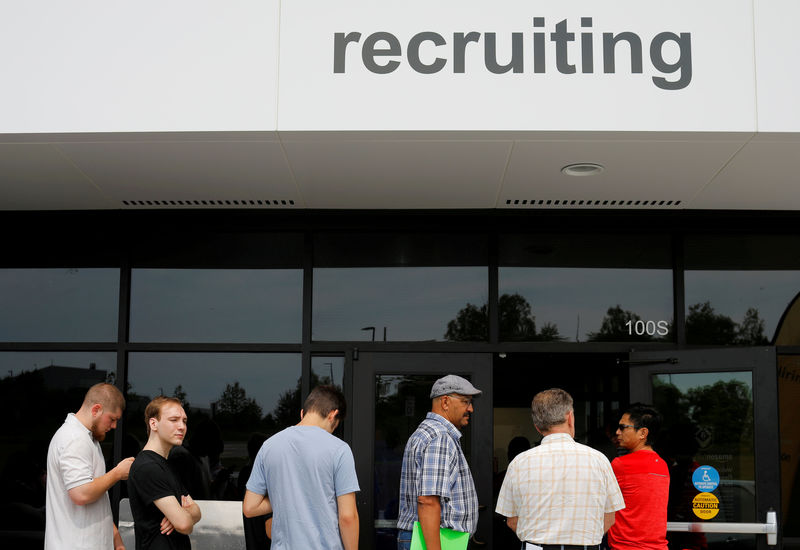 © Reuters. FILE PHOTO: Job seekers line up to apply during “Amazon Jobs Day” at the Amazon.com Fulfillment Center in Fall River
© Reuters. FILE PHOTO: Job seekers line up to apply during “Amazon Jobs Day” at the Amazon.com Fulfillment Center in Fall RiverBy Lucia Mutikani
WASHINGTON (Reuters) – U.S. services sector activity accelerated in May, pointing to robust economic growth in the second quarter, but trade tariffs and a shortage of workers posed a threat to the outlook.
Other data on Tuesday showed job openings rising to a record high in April, far outpacing hiring. Strengthening economic growth and tightening labor market conditions likely seal the case for a Federal Reserve interest rate increase next week and raise the probability of two more hikes later in the year.
“Whatever speed the economy is growing at, it isn’t going to keep moving down the road much longer if there is no one to work the economy’s factories and stores and warehouse floors,” said Chris Rupkey, chief economist at MUFG in New York.
The Institute for Supply Management (ISM) said its non-manufacturing activity index jumped 1.8 points to 58.6, ending three straight monthly declines. A reading above 50 indicates expansion in the sector, which accounts for more than two-thirds of U.S. economic activity.
The ISM survey added to bullish data on consumer spending, the labor market, manufacturing and trade that have suggested the economy was regaining speed after slowing in the first quarter. Gross domestic product estimates for the second quarter are as high as a 4.8 percent annualized rate. The economy grew at a 2.2 percent pace in the January-March period.
The dollar () was trading higher against a basket of currencies, while U.S. stocks were mixed. Prices for U.S. Treasuries rose.
The ISM survey said while service industries were optimistic about business conditions and the overall economy, there continued to be concerns about “the uncertainty surrounding tariffs, trade agreements and the impact on cost of goods sold.”
The Trump administration in March announced tariffs for steel and aluminum imports to protect domestic industries from what it says is unfair competition from foreign producers. The government last week extended the duties to steel and aluminum imports from Canada, Mexico and the European Union.
WORKER SHORTAGE
Industries complained that predicting material prices this year had been difficult, with some saying the aluminum tariff had “caused supply interruptions and higher costs.”
They are also experiencing difficulties finding qualified workers, especially truck drivers, leading to bottlenecks in the supply chain. Wholesalers described the supply chain as “shuttering because of a lack of drivers and equipment causing delays in multiple modes of transportation.”
The worker shortage was underscored by the Labor Department’s monthly Job Openings and Labor Turnover Survey, or JOLTS report showing job openings, a measure of labor demand, increased by 65,000 to a seasonally adjusted 6.7 million in April. That was the highest level since the government started tracking the series in December 2000.
The number of hires rose 92,000 to 5.6 million in April. The labor market is viewed as being either near or at full employment, with the jobless rate at an 18-year low of 3.8 percent. In April, the number of unemployed people per job opening fell to 0.9 from 1 in March.
Economists said the tight labor market could spur faster inflation than currently anticipated by Fed officials. The U.S. central bank holds its next monetary policy meeting on June 12-13. It increased borrowing costs in March and has forecast at least two more rate increases for this year.
“This will fan Fed concerns that inflation will overshoot the central bank’s 2 percent objective by more than policymakers are willing to stomach,” said Ryan Sweet, a senior economist at Moody’s Analytics in West Chester, Pennsylvania. “The Fed could be crossing its fingers that the supply side of the economy responds, helping slow or halt the unemployment rate’s decline.”
The JOLTS report also showed a moderate rise in layoffs in April, with the layoffs and discharges rate increasing to 1.2 percent from 1.0 percent in the prior month. The layoffs were mostly in the arts, entertainment and recreation, and finance and insurance industries.
The quit rate, which the Fed looks at as a measure of job market confidence, was unchanged at 2.3 percent in April.
Job openings in April were concentrated in manufacturing and information sectors. Vacancies fell in the finance and insurance industry.
Source: Investing.com




























